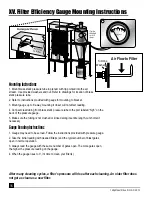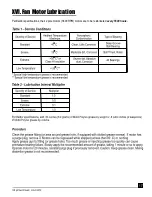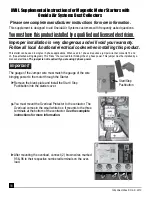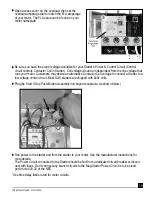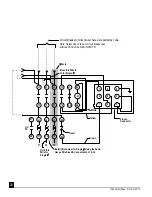
10hp Direct Drive © O.A.S. 2010
14
XIII. Fire Hazards
- Read Before Installing and Operating
Oneida Collectors are designed for WOOD DUST only!!
Wood shaping and cutting processes generate wood chips, shavings, and dust. These materials are considered combustible. Air
borne wood dust below 420 microns in size (,017 of an inch) in certain concentration ranges when ignited can deflagrate (burn quickly).
An ignition source such as a spark or ember can ignite a dust mixture resulting in an expanding flame front which can cause an explo
-
sion if tightly contained. A disturbance that raises a cloud of accumulated fine dust can raise additional dust clouds, which can cause a
series of explosions that can level an entire building. Until this type of fire has been witnessed, it is difficult to believe the devastation.
This type of fire is rare but worth safeguarding against.
The best way to avoid a wood shop fire is to keep the shop clean. A shop ankle deep in dust with layers of fine dust everywhere is an
accident waiting to happen. A good dust collection system reduces overall fire hazards but also adds new concerns. A fire hazard is still
present. Combustible material is now in the dust collector and storage container.
The following points are worth heeding:
It is the buyer’s responsibility to follow all applicable federal, state, local, OSHA, NFPA, or authorities having jurisdiction codes and
regulations when installing and operating this dust collector.
Fire marshals may want the unit located outside of the building. If the collector is located inside the facility, controls such as spark
detection, suppression, or explosion venting may be required.
Most local jurisdictions consult or adopt NFPA (National Fire Protection Agency) codes. However, other codes may apply. Local
codes may vary from jurisdiction to jurisdiction.
NFPA 664 Code book, “Standard for the Prevention of Fires and Explosions in Wood Processing and Woodworking Facilities”, ap-
plies to woodworking operations that occupy areas of more than 5,000 sq. ft. or to areas where dust producing equipment requires an
aggregate dust collection flow rate of more than 1500 cfm (cubic feet per minute). This exempts some small operators from the NFPA
code 664, but other codes may apply in your jurisdiction. Consult your local Fire Marshall for help. Additional information can be found
in NFPA Code Book 664.
The customer assumes the responsibility for contacting their insurance underwriter with regard to specific application requirements of
explosion venting or if additional fire protection and safety equipment may be required.
Do not use this product to collect other types of dust or flammable vapors.
Fire or explosion may occur!
- Never collect sparks from a bench grinder into a wood dust collector.
- Never introduce sparks or sources of ignition into the dust collector.
- Personnel should keep at least 20 feet away from unit.
- Check dust bin frequently and before leaving the shop for smoldering material.
Keep portable Fire Extinguishers handy.
- The ABC type (dry chemical) is generally a good choice for small wood shops. Additional information on portable extinguishers
can be found in NFPA 10 (Standards for Portable Fire Extinguishers).
- Be especially careful with sanding units. They can produce concentrations of dust in the combustible range. Make certain enough
air volume is at the suction point to capture all the particulate generated.
- This high air volume will dilute the mixture below the lower limit of flammability. Be careful not to generate sparks into the sanding
dust.
- Empty dust bin and clean filter often, especially when sanding.
- Don’t overload woodworking equipment, especially sanders. Excessive frictional heat can spontaneously ignite dust.
Sparks can be generated in several ways:
- High-speed sanders and abrasive planers may strike foreign material.
- Saws and edgers may strike foreign material and create a red hot metal fragment.
- Knots in hardwood can create frictional sparks.
- Tramp metal when drawn into the collector can spark against ductwork.
- Check wood stock for old nails and screws which can create red hot metal fragments.
- Avoid using excessively large wood waste storage bins.
- Always check storage bins for smoldering material before leaving for the day.
- Electrically ground all equipment and ducting. Static sparks can ignite wood dust. (Avoid using PVC drainpipe).
- Don’t allow accumulation of layers of fine dust on horizontal surfaces. (Especially overhead lights, electrical boxes, and fuse
panels which can ignite dust).

















